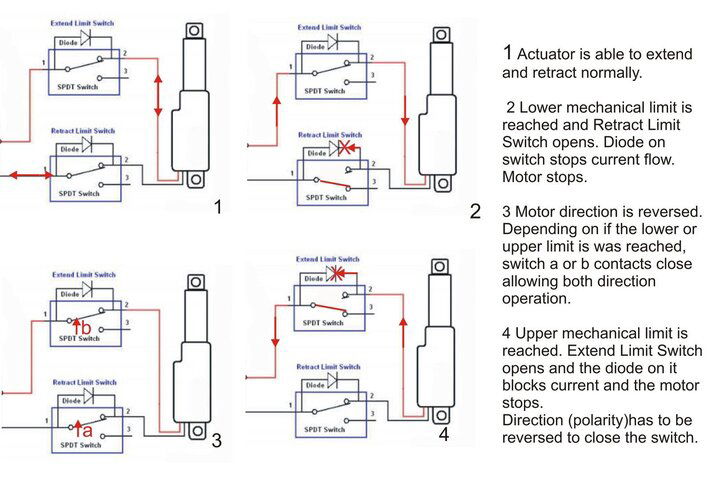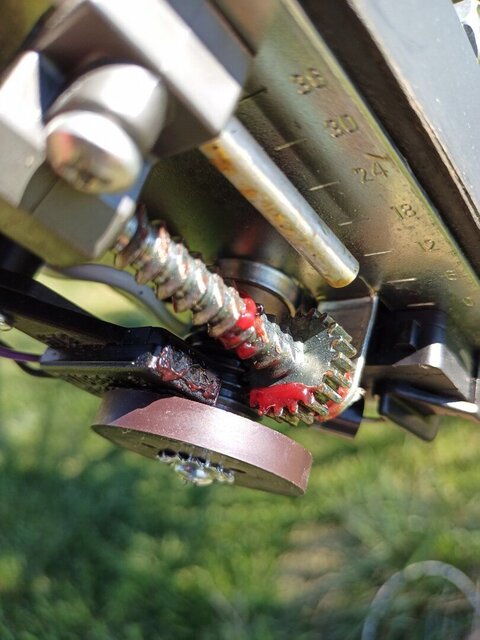Well, what can i say. A week ago, I decided to move my C-band dish to the eastern arc to get the BBC news. Wouldn't move. Went out to the actuator and just literally blew out the cobwebs. Then fiddled with the ASC1 for a while, until I finally reset all soft limits and then moved the dish manually. Afterwards, I reset soft limits to outer satellite limits. Everything worked fine in regards to moving the dish.
Been on the BBC for a week listening to updates. Wanted to bump it over a few degrees to NHK. Wouldn't move again. I tried the soft reset. Didn't work this time. The "Reach W/E Limit! Limit Switch? Sensor? Motor Blocked?" message appeared. I tried a global reset. Nothing. Cut power. I went out to the actuator, saw there was a little corrosion on one of the power wires from the ASC1. Cleaned it off and reconnected it. Tried the soft reset again. "Position 0000, W limit 0005, E limit -0005" Manually tried to move W or E, but won't budge (not even to 0001), and still get the Reach W/E Limit! Limit Switch? Sensor? Motor Blocked? message. Tried using a VBOX7, and I got an Err2 message. No motion. I hooked it up back and forth, and just left it with the VBOX7 for now, although it still won't budge.
The road crew did knock the power off while I was at work this past week.
I heard switches go out in actuators. Could that be the problem? I have no idea how to replace it or determine if it's the problem. I just find it odd that last week, the soft reset worked and the actuator itself behaved fine. So, I'm inclined to think it may be something I'm not doing right with the ASC1. Yet, it doesn't do anything with the VBOX7 either. Right now, the dish is stuck and does not move at all. I haven't tried a car battery on the motor. What are the steps to doing that? Or other advice out there?
Been on the BBC for a week listening to updates. Wanted to bump it over a few degrees to NHK. Wouldn't move again. I tried the soft reset. Didn't work this time. The "Reach W/E Limit! Limit Switch? Sensor? Motor Blocked?" message appeared. I tried a global reset. Nothing. Cut power. I went out to the actuator, saw there was a little corrosion on one of the power wires from the ASC1. Cleaned it off and reconnected it. Tried the soft reset again. "Position 0000, W limit 0005, E limit -0005" Manually tried to move W or E, but won't budge (not even to 0001), and still get the Reach W/E Limit! Limit Switch? Sensor? Motor Blocked? message. Tried using a VBOX7, and I got an Err2 message. No motion. I hooked it up back and forth, and just left it with the VBOX7 for now, although it still won't budge.
The road crew did knock the power off while I was at work this past week.
I heard switches go out in actuators. Could that be the problem? I have no idea how to replace it or determine if it's the problem. I just find it odd that last week, the soft reset worked and the actuator itself behaved fine. So, I'm inclined to think it may be something I'm not doing right with the ASC1. Yet, it doesn't do anything with the VBOX7 either. Right now, the dish is stuck and does not move at all. I haven't tried a car battery on the motor. What are the steps to doing that? Or other advice out there?
Last edited:




